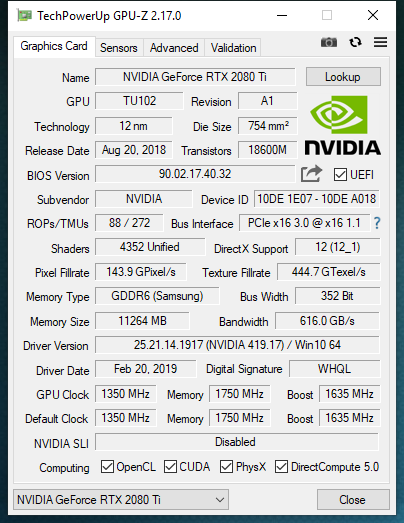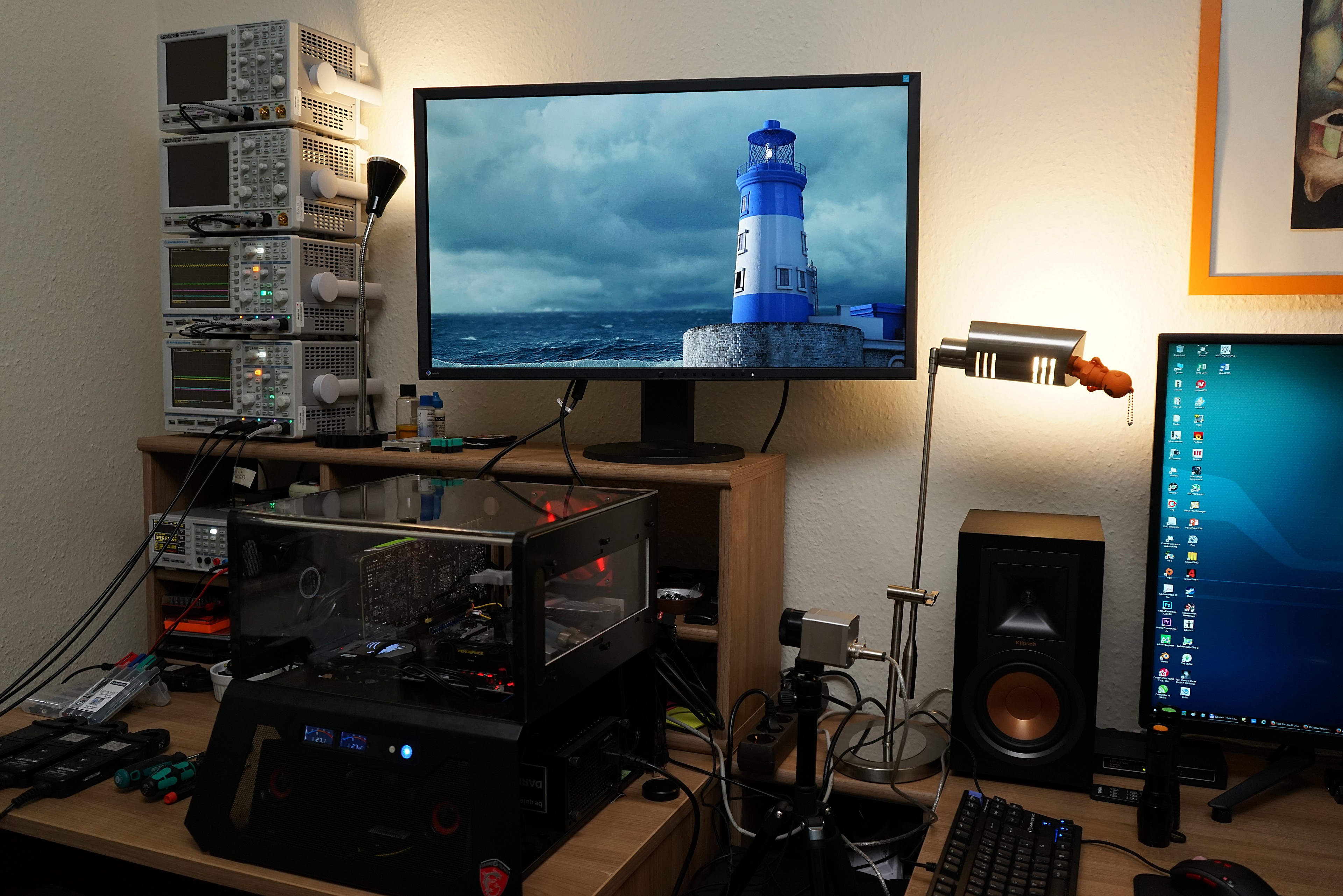The Hall of Fame (HoF for short) has been the spearhead of the individual performance classes at KFA2 (Galax) for years. It is easy to argue about design and not being, but white cards are rare and are highly sought after because it is hard to get anywhere else. The manufacturer also offers with this card a lot of features, which can only be found on a few other maps. A GeForce RTX 2080 Ti can be anyone, but a white card with enough bling factor, gold edge, crown, OLED display and 450-watt BIOS is something of over that it already has enormous charm.
Apart from the overall rather baroque superstructure and the extremely expansive plastic oversize, the manufacturer naturally puts a lot of the latest technology on the white board. That is to say, at KFA2 it also counts the inner values, whereby the card is in fact the blonde with Abitur among the thickest specimens of the RTXe. You have to be conspicuous and smart first and because of all the gilding, at least one would hyperventilate in presidential rapture if he ever saw it. And with three fans and the continuous wind button, it is also the Hairforce One among the Pixel jumbos.
The 1438 gram card is 31.7 cm long, measures from top edge slot panel to top edge graphics card case is plentiful 14 cm and is 5.2 cm thick. In addition, there is just under 0.5 cm for the aluminium backplate. This means that the card can encounter certain space problems if the housings are too small simply because of the height. The cover is made of white plastic with optical accents, such as a gold edge painting and an aluminium plate below the OLED display.
At the top, the willing buyer will find exactly this OLED display, which can be controlled via the in-house AI software and is also able to display various status values in real time. The card also features a dual BIOS (dip switch at the end of the card) and a button to balance fan speeds to 100% via one-click. This is quite noisy and is at the level of Radeon VII. In addition to the NVLink at the top, the slot panel also contains the usual three DisplayPort ports, once HDMI 2.0 and the USB-C port.
The remaining details can be found in the following picture gallery and of course also in the description of board details and coolers including a long tear-down video on the next page. I don't want to pre-empt this, but I also want to get the first-page-last-page readers to turn over.
KFA2 delivers the card with three external 8-pin ATX power supply connectors, which are located at the back of the card and not at the top because of the height of the card. The complete connection is mandatory and we will also see why. All previous Turing cards with the TU102 did not reach 380 Watt++ power consumption for the entire card even with OC and raising the predetermined power target, which could also be changed this time with a little effort. But more on that later. The screenshot of GPU-Z gives us a first impression:

Technical data and comparison maps
At the end of this introduction, the maps of the new generation and those of the old generation in direct tabular comparison:
| KFA2 GeForce RTX 2080 Ti Hall of Fame |
Nvidia GeForce RTX 2080 Ti Fe |
Nvidia GeForce RTX 1080 Ti Fe |
Nvidia GeForce RTX 2080 Fe |
Nvidia GeForce RTX 1080 Fe |
|
| Chip | Turing (TU102) | Turing (TU102) | Pascal (GP102) | Turing (TU104) | Pascal (GP104) |
| CUDA Cores |
4352 | 4352 | 3584 | 2944 | 2560 |
| Tensor-Cores | 544 | 544 | No | 368 | No |
| RT Cores | 68 | 68 | No | 48 | No |
| TMUs | 272 | 272 | 224 | 184 | 160 |
| Basic clock | 1350 | 1350 MHz | 1480 MHz | 1515 MHz | 1607 MHz |
| Boost clock | 1635 | 1635 MHz | 1582 MHz | 1800 MHz | 1733 MHz |
| Memory | 11GB GDDR6 | 11GB GDDR6 | 11GB GDDR5X | 8GB GDDR6 | 8GB GDDRX5 |
| Interface | 352-bit | 352-bit | 352-bit | 256-bit | 256-bit |
| Memory bandwidth | 616 GB/s | 616 GB/s | 484 GB/s | 448 GB/s | 320 GB/s |
| Rops | 88 | 88 | 88 | 64 | 64 |
| L2 cache | 5.5MB | 5.5MB | 2.75MB | 4MB | 2MB |
| Tdp | 450W (300W) |
260W | 250w | 225W | 180w |
| Transistors | 18.6 billion | 18.6 billion | 12 billion | 13.6 billion | 7.2 billion |
| Chip size | 754 mm2 | 754 mm2 | 471 mm2 | 545 mm2 | 314 mm2 |
| Sli | Yes (x8 NVLink, x2) | Yes (x8 NVLink, x2) | Yes (MIO) | Yes (x8 NVLink) | Yes (MIO) |
Test system and measurement methods
We have already described the new test system and the methodology in detail in the basic article "How We Test Graphics Cards, as of February 2017" and therefore refer to this detailed basis for simplicity. Description. So if you want to read everything again, you are welcome to do so. However, we have again improved CPU and cooling to largely exclude possible CPU bottlenecks for this fast card.
If you are interested, the summary in table form quickly provides a brief overview:
| Test systems and measuring rooms | |
|---|---|
| Hardware: |
Intel Core i7-8700K x 5 GHz MSI Z370 Gaming Pro Carbon AC 16GB KFA2 DDR4 4000 Hall of Fame 1x 1 TByte Toshiba OCZ RD400 (M.2, System SSD) 2x 960 GByte Toshiba OCZ TR150 (Storage, Images) Be Quiet Dark Power Pro 11, 850-watt power supply |
| Cooling: |
Alphacool Ice Block XPX 5x Be Quiet! Silent Wings 3 PWM (Closed Case Simulation) Thermal Grizzly Kryonaut (for cooler change) |
| Housing: |
Lian Li PC-T70 with expansion kit and modifications Modes: Open Benchtable, Closed Case |
| Monitor: | Eizo EV3237-BK |
| Power consumption: |
non-contact DC measurement on the PCIe slot (Riser-Card) non-contact DC measurement on the external PCIe power supply Direct voltage measurement on the respective feeders and on the power supply 2x Rohde & Schwarz HMO 3054, 500 MHz multi-channel oscillograph with memory function 4x Rohde & Schwarz HZO50, current togor adapter (1 mA to 30 A, 100 KHz, DC) 4x Rohde & Schwarz HZ355, touch divider (10:1, 500 MHz) 1x Rohde & Schwarz HMC 8012, digital multimeter with storage function |
| Thermography: |
Optris PI640, infrared camera PI Connect evaluation software with profiles |
| Acoustics: |
NTI Audio M2211 (with calibration file) Steinberg UR12 (with phantom power for the microphones) Creative X7, Smaart v.7 own low-reflection measuring room, 3.5 x 1.8 x 2.2 m (LxTxH) Axial measurements, perpendicular to the center of the sound source(s), measuring distance 50 cm Noise in dBA (Slow) as RTA measurement Frequency spectrum as a graph |
| Operating system | Windows 10 Pro (1803, all updates) |
KFA2 GeForce RTX 2080 Ti HOF, 11GB GDDR6, HDMI, 3x DP, USB-C (28IULBUCV6DK)










































Kommentieren